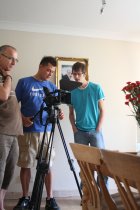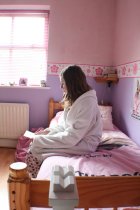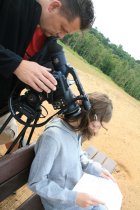|
Since I started film making at the age of 15 in 1989 a lot
has changed.
I formed The Channel 7 Video Making Club in 1994 with
Richard Palmer* and armed with lots of spare time and
enthusiasm we churned out 6 or 7 productions a year,
making dramas, music videos, stage recordings,
documentaries, etc.
However all that came to an end with the birth of my two
children which as every parent will know has a deep
impact on any spare time you might have. My Director
Lindsay Townley is also a parent. So for the past 6
years or so the Club has been producing films every two
years or so.
Due to time constraints, the productions have been
filmed in what I will call soap style filming. A wide
shot and a close ups of each of the various actors with
dialogue. This achieves the goal, but doesn't really use
the 'film' medium to its advantage and looks visually
dull.
When Lindsay and I were discussing our project for 2012
we said we wanted to go back to basics, to let the
pictures do the talking and to try out some modern
camera techniques, such as slow tracking, etc.
Rather than embark on a big project not really knowing
how to use some of the techniques and styles we decided
to create a small project to test some of our ideas.
We wanted a piece with a reflective style with little or
no dialogue to avoid over complicating things, so we
could concentrate on the pictures telling the story. We
wanted to
test different camera techniques to see how they would
edit together. For example does it look right if you go
from a tracking shot to a stationary shot? All good on
paper, but we'd not really tried it.
So with this all in mind I came up with the idea of a
girl receiving a letter. The plot was to be simple: a
girl receives a letter she doesn't want to open as it
could be good or bad news; she spends a lot of time
thinking about opening it; then she plucks up the
courage, revealing the outcome.
So we then roughly translated this into a script which
consisted of a sort of shot list:
The Letter
Letter is leaning up against something on breakfast
table.
Girl dressed in pyjamas comes to pick it up.
She looks at the envelope
She looks, excited and worried all at the same time.
She pauses and then thinks about opening it.
She then sits at a table for breakfast.
Tablet(s)?
She goes to open it, she cant bring herself to open
it.
She then paces about trying to bring herself to open
it.
...
Once we had our script we then started to look for an
actress to play the lead part. Our aim with all Channel
7 productions is to have a child take the lead. This is
now part of our club's mandate, but in the early days it
stemmed from when I began film making using friends of
friends. At 17 I did not have the confidence to direct
adults and then I also found it easier to cast children
as they have spare time!
So we did what we usually do, contacted the local
schools, contacted the local press and advertised on our
website for someone to play the role. Sadly after
various promises from people, no-one turned up. This
shook us up quite a bit, as our usual way of recruiting
had failed.
So with this in mind we had a choice, try again in a few
weeks time or go back to our audition tapes from two
years ago to see if there was anyone suitable. No-one
sprang to mind at first because we auditioned for a
completely different role.
Eventually we chose a girl, who we tried to contact
several times, but again failed as she had moved away.
Telephone numbers and emails all bounced.
So we went back to the tapes again. This time we thought
a little harder about what we were looking for and then
we spotted Elissia Styles. She didn't stand out as she
was quite shy and nervous at her audition, but when we
looked a little harder she was exactly what we were
looking for. After a quick telephone call she agreed to
do the part for us.
A few weeks later we had a one rehearsal with Elissia so
that we all knew what was expected. We rehearsed some
camera movements and blocked out some of the script with
her.
Both Lindsay and I planned each of the three scenes
carefully before we started shooting. We decided what
the girl would wear and what she'd be eating, whether or
not she'd have flowers on the table, who the letter
would be addressed to, etc. We analysed everything and
planned accordingly. It sounds obvious but we have
'winged' it on a lot of occasions and we felt we needed
to pay more attention to the detail. With no dialogue
the pictures had to do the talking.
Filming took two mornings in early June 2011. We took
many different shots and angles, probably too many, but
we wanted to see what would work well. Focusing was
extremely hard as we used the telephoto end of the lens
a lot to give a more filmy look, especially with the
tracking shots.
We lit the kitchen scene with 3 red heads, heavily
gelled and placed in natural positions to mimic the
natural light that would have fallen. In the girl's
room, we used natural light with a reflector to fill in
the shadows.
The final scene was filmed in Sandy, Bedfordshire.
Cambridgeshire, where we're based, isn't known for its
hills! We wanted a solitary place that overlooked her
town where she could be alone to read her letter in
peace.
Editing was difficult at first as there was no immediate
pace to the piece. No dialogue meant nothing to work
with other than pictures. So I chose a piece of
commercial music to edit to, which we replaced later.
This made the task much easier.
After completing a few hours editing, I stripped off the
music and asked our resident composer to add some music
for us. A few weeks later the music was complete.
All that was left now was to put the pieces together and
to put it onto a DVD. So the finished film was complete
by July 2011.
|










